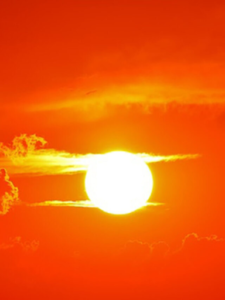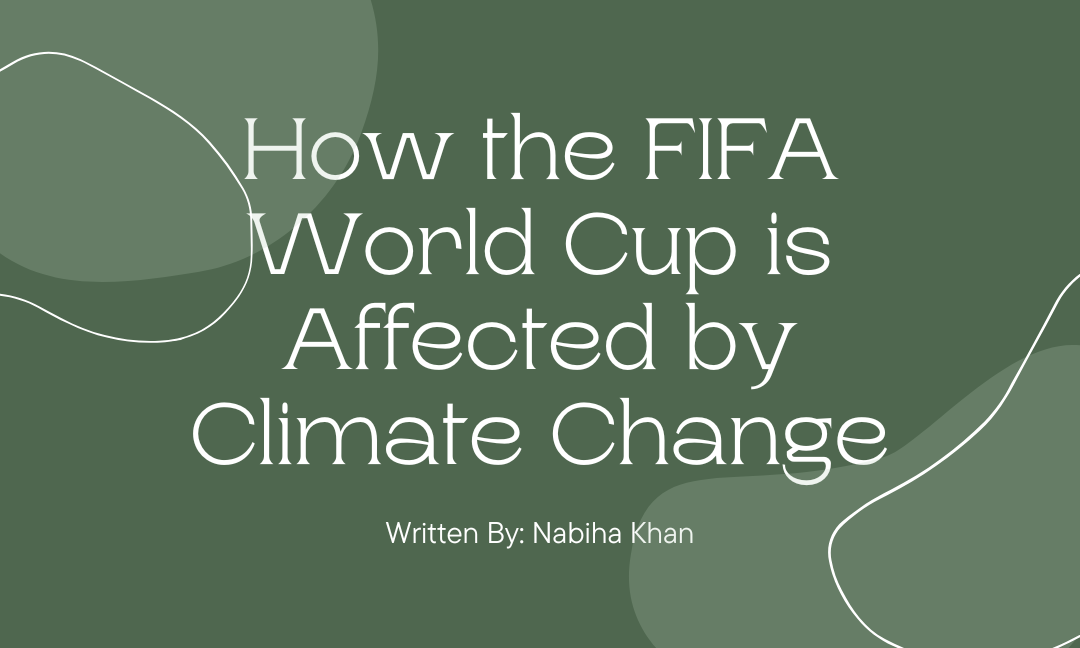Written by: Nabiha Khan
Edited by: Tianna Mair
Designed by: Jiya Mehta
Published by: Maryam Khan
The FIFA World Cup is back and running, with lots of fans cheering for their home countries in full spirit. In this article, I will briefly explain how climate change is affecting stadiums in Qatar, and the potential consequences and changes it can make to the World Cup this year.

Photo provided on Wikipedia
As the FIFA World Cup is back, a lot of people are changing their regular everyday schedules to watch the matches that are played every day. As a fan myself, I’m also spending more time on this event rather than other things. Unfortunately, due to that, many have disregarded the events of climate change, and just want to have a little fun. I am going to relate climate change to the FIFA World Cup, and explain how pollution is affecting everyone’s favourite sports event.
I’d like to start with the blazing weather in Qatar. It is estimated to be 30 degrees celsius, despite being played in the Winter. You might’ve guessed that the only reason for this burning weather isn’t just where it’s hosted, it’s also climate change.
The temperatures in Doha are 3 degrees celsius hotter in the day than usual, which is another result of climate change. Due to all of Qatar warming up to almost 3 times hotter than usual, many are starting to feel the effects, including the athletes and fans.
Qatar has tried ways to prevent this heat wave, such as using a lot of air conditioning in stadiums, but they’re not very effective altogether.

Photo Provided by Stadia Magazine
So what could this mean for the results of the FIFA World Cup? This might seem like an attempt for climate activists to bring back everyone’s attention to climate change, but it can actually have severe consequences on the FIFA World Cup and its matches.
Athletes, especially those not used to warmer weather, will have a harder time playing in Qatar. This is a huge disadvantage and unfair since they’re not used to that sort of weather. Although many might have had years of training beforehand, it’s hard not to get injuries from the heat in Qatar.
Many athletes, especially ones playing from colder countries like Canada, can expect lots of exhaustion from the tiring heat, and could even suffer mild injuries that prevent them from playing in matches. Doing so could potentially remove star players from teams, preventing them from being able to get out of the group stages.
Fatigue due to all the intense heat is also a very common symptom, and might even affect players from warmer countries. This causes excessive sweating and doesn’t allow the players to play to the best of their abilities. This might be another disadvantage for players from colder countries since players from warmer countries would be used to scorching heat.
Even for players who are used to this sort of weather, heart complications could be a concern for them, as playing in scorching heat can lead to many heart problems. Especially if they’re dehydrated, it could lead to some serious issues. These include severe cramps, dehydration, and in the worst-case scenario, a heat stroke.
What this means is that climate change not only risks injury to the player’s health, but it can also potentially cause death. Although heat stroke doesn’t necessarily mean death, it can also create severe injuries that could ruin the player’s career.

Photo Provided by RawPixel
It doesn’t end there though, not only could it lead to injuries, ruining a player’s career or in some severe cases death for athletes, but this could also affect fans who gather together to watch the game.
Although their chances of injury would be much smaller considering that they’re not overgoing constant exercise, there are still chances of dehydration and heat stroke for them as well. This especially goes for fans who come from colder areas.
Altogether, the intense heat in Qatar is affecting everyone there, this is just another reason for us to lower our carbon footprint.
So, how can we do that?
It’s simple! We can lower our carbon footprint by turning off lights when not in use, unplugging chargers when not in use, using fewer resources than needed, buying carbon-free products and simply just spreading the word.
If everyone tries to make an impact to save our world, it’s entirely possible. Who knows? The next World Cup might not be a little cooler because of us!
Photo Provided by Public Domain Vectors
Sources:
Dermansky, Michael. “Exercising in the Heat – the Good and Bad.” MD Health, MD Health, 16 Aug. 2022, https://mdhealth.com.au/exercising-in-the-heat-the-good-and-bad/#:~:text=As%20the%20temperature%20rises%20and,your%20base%20level%20of%20fitness.
Desk, Reporters. How To Stay Safe During Extreme Heat, Random Lengths News, 9 June 2022, https://www.randomlengthsnews.com/archives/2022/09/06/stay-safe-during-heat-wave/41432.
“File:Fifa World Cup Org.png.” Wikipedia, Wikipedia, https://en.wikipedia.org/wiki/File:Fifa_world_cup_org.png. Accessed 1 Dec. 2022.
“Planet Earth Clip Art.” Planet Earth Clip Art | Public Domain Vectors, Public Domain Vectors, https://publicdomainvectors.org/en/free-clipart/Planet-Earth-clip-art/85189.html.
“World Cup Warming up Because of Climate Change.” Dhaka Tribune – Current & Breaking News Bangladesh & World, Dhaka Tribune, 30 Nov. 2022, https://www.dhakatribune.com/fifa-world-cup-2022/2022/11/30/world-cup-warming-up-because-of-climate-change.

